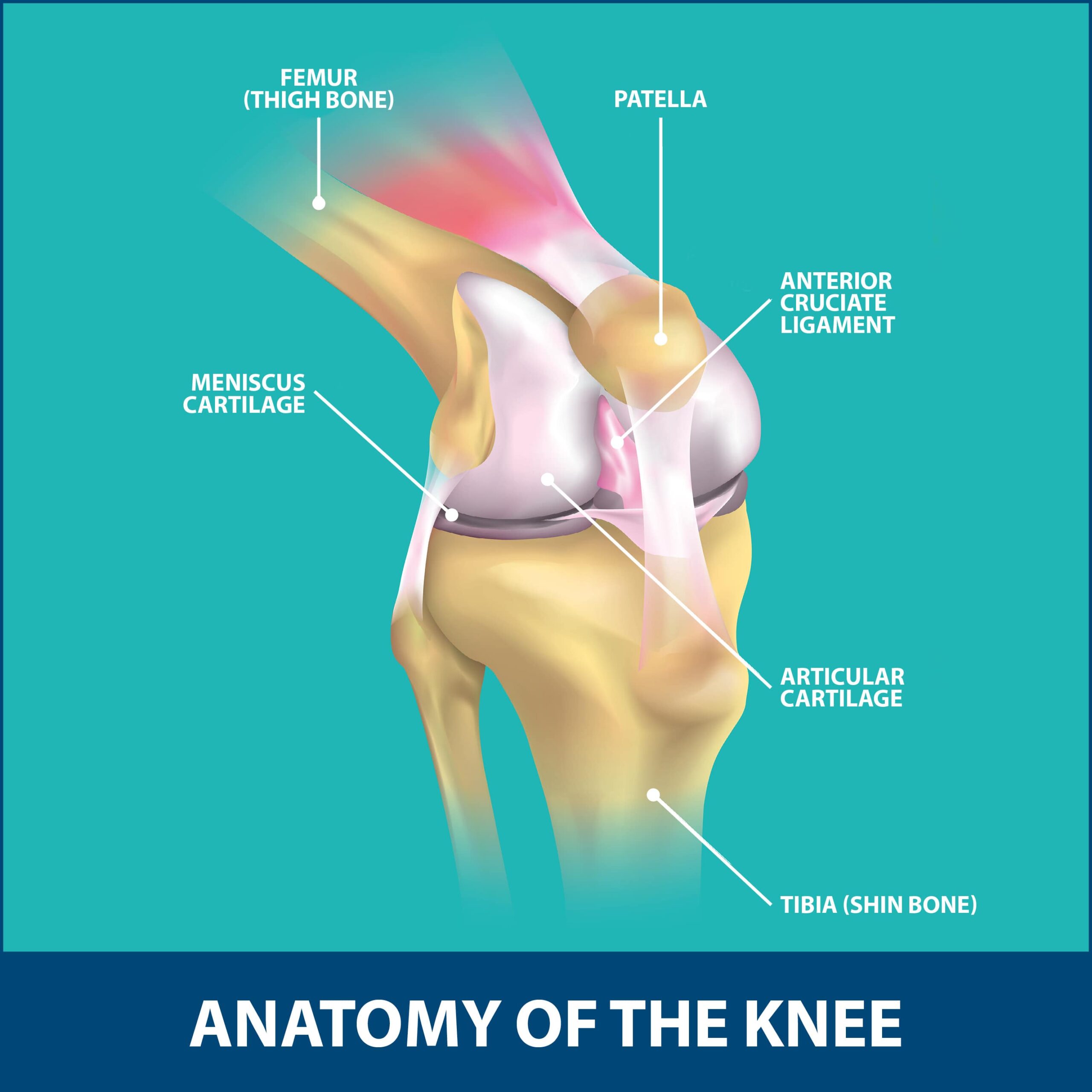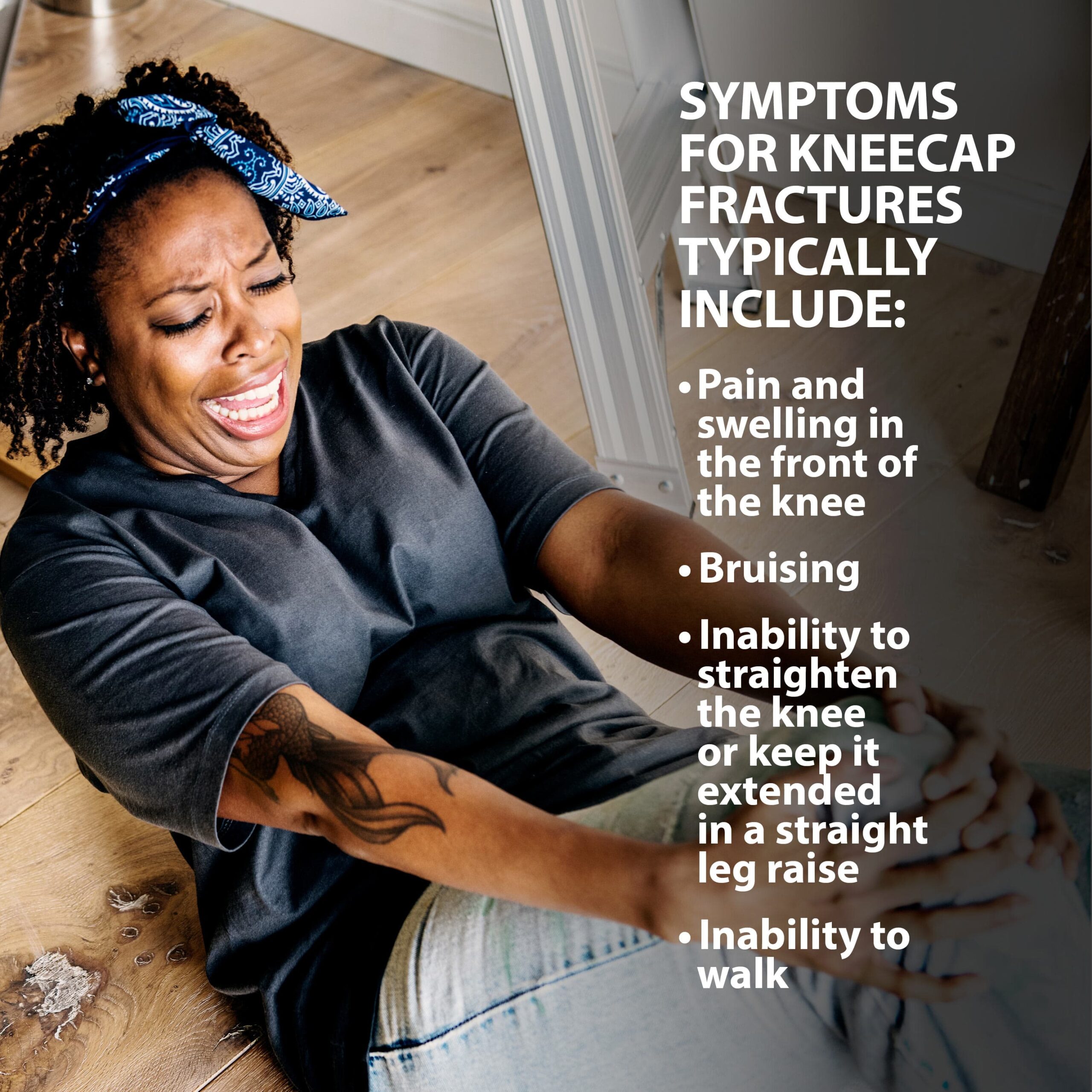Patellar Fracture
OVERVIEW
A patellar fracture is a break in the kneecap (the patella) – the small bone that sits at the front of your knee. Because the patella acts as a shield for your knee joint, it is very vulnerable if you fall directly on it or hit it forcefully. A patellar fracture is a severe injury that can make it difficult or even impossible to straighten your knee or walk. This injury can be treated both surgically and non-surgically, depending on the type and severity of the fracture.
ANATOMY
The patella is a small bone located in front of the knee joint located where the thighbone (femur) and shinbone (tibia) meet. It protects the knee and connects the muscles in the front of the thigh to the tibia. The ends of the femur and the undersides of the patella are covered with a smooth substance called articular cartilage, which helps the bones glide smoothly along each other as you move your knee.

DESCRIPTION
The patella, also known as the knee cap, can fracture in many different ways from a variety of different causes. For example, a break can occur at the top, center, or lower part of the bone. The patella can also break in two clean pieces or many small pieces. The different types of fractures are as follows:
- Displaced fracture. In this type of fracture, the broken ends of the bone are separated and do not line up correctly and often need surgery to put the pieces of bone back together.
- Open fracture. In an open fracture, the bone breaks in such a way that bone fragments stick out through the skin. An open fracture often involves damage to the surrounding soft tissues and may take longer to heal.
- Comminuted fracture. In comminuted fractures, the bone shatters into three or more pieces. Depending on the specific pattern of the fracture, a comminuted fracture may be either stable or unstable.
Patellar fractures are usually caused by a brute force accident, like falling directly onto the knee or receiving a sharp blow to the knee. The kneecap can also be fractured indirectly. For example, a sudden contraction of the thigh muscles (quadriceps) can pull apart the patella.
SYMPTOMS
- Symptoms for kneecap fractures typically include:
- Pain and swelling in the front of the knee.
- Bruising.
- Inability to straighten the knee or keep it extended in a straight leg raise.
- Inability to walk.

DIAGNOSIS
Your Florida Orthopaedic Institute physician will look at your symptoms and medical history, followed by a physical examination. During the exam, your physician will keep an eye out for the edges of the fracture that can often be felt through the skin, especially if the fracture is displaced.
Your physician will also check for hemarthrosis. In this condition, blood from the fractured bone ends collects inside the joint space, causing painful swelling. If you have a large amount of blood in your knee, your doctor may drain it to help relieve your pain.
Your physician may also order an x-ray to help confirm the diagnosis, which will produce images of dense structures in the body, such as bone.
TREATMENT OVERVIEW
A patellar fracture can be treated both surgically and non-surgically, depending on the type and severity of the fracture.
NON-SURGICAL TREATMENTS
If the bone pieces are not displaced, you may not need surgery. Your Florida Orthopaedic Institute physician may apply a cast or splint to keep your knee straight and help prevent motion in your leg. This keeps the broken ends of the bones in proper position while they heal.
Depending upon your fracture, you may also be allowed to bear weight on your leg while wearing a cast or brace. With some fractures, weight-bearing is not allowed for 6 to 8 weeks.
SURGICAL TREATMENTS
If the pieces of bone are out of place (displaced), you will most likely need surgery. The type of procedure performed often depends on the type of fracture you have. Your Florida Orthopaedic Institute physician will determine which surgical procedure is best for you.
Two main types of fractures typically require surgery:
- Transverse Fracture. This procedure treats fractures located near the center of the patella. These two-part fractures are most often fixed in place using screws or pins and wires and a “figure-of-eight” configuration tension band. The figure-of-eight band presses the two pieces together.
- Comminuted Fracture. In some fractures, the patella is broken into several small pieces. This type of fracture occurs when the kneecap is first pulled apart from the injury and then crushed when the patient falls on it. Because the bone fragments are too small to be fixed back into place, your surgeon will remove them and then attach the loose patellar tendon back to the remaining patellar bone.
NEXT STEPS
Talk to your Florida Orthopaedic Institute physician to learn more about patellar (kneecap) fractures.
Areas of Focus
- Knee & Leg
- ACL Injuries
- Arthroscopic Chondroplasty
- Articular Cartilage Restoration
- Deep Thigh Bruising
- Fractures Of The Tibial Spine
- Iliotibial Band Syndrome
- Lateral Collateral Ligament (LCL) Injuries
- MACI
- Medial Collateral Ligament Injuries
- Meniscus Tears
- Muscle Spasms
- Muscle Strains of The Calf
- Partial Knee Replacement
- Patellar Fracture
- Quadriceps Tendon Tear
- Runner's Knee
- Senior Strong
- Shin Splints
- Total Knee Replacement Surgery
The following Florida Orthopaedic Institute physicians specialize in Patellar Fractures:
Specialties
- AC Joint Injuries
- Achilles Tendinitis - Achilles Insertional Calcific Tendinopathy (ACIT)
- Achilles Tendon Rupture
- Achilles Tendonitis
- ACL Injuries
- Ankle Fracture Surgery
- Ankle Fractures (Broken Ankle)
- Ankle Fusion Surgery
- Anterior Cervical Corpectomy & Discectomy
- Arthroscopic Articular Cartilage Repair
- Arthroscopic Chondroplasty
- Arthroscopic Debridement of the Elbow
- Arthroscopy Of the Ankle
- Articular Cartilage Restoration
- Artificial Disk Replacement (ADR)
- Aspiration of the Olecranon Bursa - Fluid In Elbow
- Atraumatic Shoulder Instability
- Avascular Necrosis (Osteonecrosis)
- Bankart Repair
- Basal Joint Surgery
- Bicep Tendon Tear
- Bicep Tenodesis
- Bone Cement Injection
- Bone Growth Stimulation
- Bone Health Clinic
- Broken Collarbone
- Bunions
- Bursitis of the Shoulder (Subacromial Bursitis)
- Calcific Tendinitis of the Shoulder
- Carpal Tunnel Syndrome
- Charcot Joint
- Chiropractic
- Clavicle Fractures
- Colles’ Fractures (Broken Wrist)
- Common Foot Fractures in Athletes
- Community Outreach
- Cubital Tunnel Syndrome
- De Quervain's Tenosynovitis
- Deep Thigh Bruising
- Degenerative Disk Disease
- Diffuse Idiopathic Skeletal Hyperostosis (DISH)
- Discectomy
- Discitis Treatment & Information
- Dislocated Shoulder
- Dupuytren’s Disease
- Elbow
- Elbow Bursitis
- Elbow Injuries & Inner Elbow Pain in Throwing Athletes
- Epidural Injections for Spinal Pain
- Finger Dislocation
- Flexor Tendonitis
- Foot Stress Fractures
- Foot, Ankle & Lower Leg
- Foraminotomy
- Fractured Fingers
- Fractures Of The Shoulder Blade (Scapula)
- Fractures Of The Tibial Spine
- Functional Nerve Transfers of The Hand
- Ganglion Cysts
- General Orthopedics
- Glenoid Labrum Tear
- Golfer's Elbow
- Groin Strains and Pulls
- Growth Plate Injuries Of The Elbow
- Hallux Rigidus Surgery - Cheilectomy
- Hammer Toe
- Hamstring Injuries
- Hand & Finger Replantation
- Hand & Wrist
- Hand Nerve Decompression
- Hand Skin Grafts
- Hand, Wrist, Elbow & Shoulder
- Heat Injury/Heat Prostration
- High Ankle Sprain (Syndesmosis Ligament Injury)
- Hip & Thigh
- Hip Arthroscopy
- Hip Dislocation
- Hip Flexor Strains
- Hip Fractures
- Hip Hemiarthroplasty
- Hip Impingement Labral Tears
- Hip Muscle Strains
- Hip Pointers and Trochanteric Bursitis
- Hyperextension Injury of the Elbow
- Iliopsoas Tenotomy
- Iliotibial Band Syndrome
- Impingement Syndrome of the Shoulder
- Interlaminar Implants
- Interlaminar Lumbar Instrumental Fusion: ILIF
- Interventional Pain Management
- Interventional Spine
- Intraarticular Calcaneal Fracture
- Joint Replacement
- Knee & Leg
- Kyphoplasty (Balloon Vertebroplasty)
- Kyphosis
- Labral Tears Of The Hip (Acetabular Labrum Tears)
- Laminectomy: Decompression Surgery
- Lateral Collateral Ligament (LCL) Injuries
- Lisfranc Injuries
- Little League Shoulder
- LITTLE LEAGUER'S ELBOW (MEDIAL APOPHYSITIS)
- Lumbar Epidural Steroid Injection
- Lumbar Interbody Fusion (IBF)
- MACI
- Mallet, Hammer & Claw Toes
- Medial Collateral Ligament Injuries
- Meniscus Tears
- Metatarsalgia
- Minimally Invasive Spine Surgery
- Morton’s Neuroma
- Muscle Spasms
- Muscle Strains of The Calf
- Nerve Pain
- Neuromas (Foot)
- Neurosurgery
- Olecranon Stress Fractures
- Orthopaedic Total Wellness
- Orthopaedic Trauma
- Orthopedic Physician Or A Podiatrist? Definition of a Podiatrist
- Osteoarthritis of the Hip
- Osteoporosis
- Outpatient Spine Surgery
- Partial Knee Replacement
- Patellar Fracture
- Pelvic Ring Fractures
- Peripheral Nerve Surgery (Hand) Revision
- Pinched Nerve
- Piriformis Syndrome
- Piriformis Syndrome
- Plantar Fasciitis
- Plastic Surgery
- Podiatry
- Primary Care Sports Medicine
- Quadriceps Tendon Tear
- Radial Tunnel Syndrome (Entrapment of the Radial Nerve)
- Revascularization of the Hand
- Reverse Total Shoulder Replacement
- Rheumatoid Arthritis (RA) of the Shoulder
- Rheumatoid Arthritis Of The Hand
- Robotics
- Rotator Cuff Tears
- Runner's Knee
- Sacroiliac Joint Pain
- Sciatica
- Scoliosis
- Senior Strong
- Shin Splints
- Shoulder
- Shoulder Arthritis
- Shoulder Arthroscopy
- Shoulder Injury: Pain In The Overhead Athlete
- Shoulder Replacement
- Shoulder Separations
- Shoulder Socket Fracture (Glenoid Fracture)
- SLAP Tears & Repairs
- Spinal Fusion
- Spine
- Spondylolisthesis and Spondylolysis
- Sports Foot Injuries
- Sports Hernias (Athletic Pubalgia)
- Sports Medicine
- Sports Wrist and Hand Injuries
- Sprained Ankle
- Sprained Wrist Symptoms and Treatment
- Subacromial Decompression
- Sudden (Acute) Finger, Hand & Wrist Injuries
- Targeted Muscle Reinnervation (TMR)
- Tendon Transfers of The Hand
- Tennis Elbow Treatment
- Thigh Fractures
- Thigh Muscle Strains
- Thumb Ulnar Collateral Ligament Injuries
- Total Ankle Replacement
- Total Hip Arthroplasty
- Total Hip Replacement - Anterior Approach
- Total Knee Replacement Surgery
- Trapezius Strain (Muscle Strain of The Upper Back)
- Traumatic Shoulder Instability
- Tricep Pain & Tendonitis
- Trigger Finger
- Turf Toe
- UCL (Ulnar Collateral Ligament) Injuries
- Ulnar Neuritis
- Valgus Extension Overload
- Vertebroplasty
- WALANT (Wide Awake Local Anesthesia No Tourniquet)
- Whiplash and Whiplash Associated Disorder (WAD)
- Wound Care
- Wrist Arthroscopy
- Wrist Fractures
- Wrist Tendonitis
Services
- Physical Medicine & Rehabilitation
- Physical Therapy
- Primary Care Sports Medicine
- PROMs (Patient-Reported Outcome Measures)
- Same-Day Orthopaedic Appointments Now Available
- Sports Medicine
- Sports-Related Concussion Treatment
- Telehealth Page
- Telemedicine
- Workers' Compensation
- Workers' Compensation Dispensary
- X-Ray
